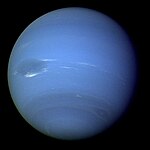Neptunus ringar
| Neptunus ringar | |
| Planetarisk ring | |
 Ett par av Neptunus svaga ringar | |
| Upptäckare | Patrice Bouchet, Reinhold Häfner, Jean Manfroid vid La Silla |
|---|---|
| Upptäckt år | 1610 |
| Ringdata | |
| Avstånd från planeten Neptunus centrum | 40 900 - 62 932 km |
Neptunus har ett svagt ringsystem bestående av flera distinkta ringar, och ovanliga ringbågar som finns Adamsringen. Partiklarna i ringarna är ovanligt mörka och innehåller en stor del mikroskopiskt damm.
Bevis på att ringarna hittades först i mitten av 1980-talet, då stjärnockulationer visade att ljuset "blinkade" till precis innan och efter Neptunus ockulerade stjärnan. Bilder från Voyager 2 1989 förklarade saken genom att visa ett ringsystem, av flera små svaga ringar.
Den yttersta ringen (Adams) innehåller tre namngivna ringar: Liberté, Egalité, och Fraternité (Frihet, Jämlikhet och Broderskap). Existensen av bågarna är svårbegriplig då rörelselagarna anger att ringarna spritts ut till en jämn ring över väldigt kort tid. Den gravitationella effekten från Galatea, månen precis innanför ringen, tror man har orsakat ringarna.
| |||||||||||||||||||||||||||||||||||||||
| |||||||||||||||||||||||||||||||||||||||||||||||||||||||||||
Media som används på denna webbplats
Major Solar System objects. Sizes of planets and Sun are roughly to scale, but distances are not. This is not a diagram of all known moons – small gas giants' moons and Pluto's S/2011 P 1 moon are not shown.
Neptune
Original Caption Released with Image: During August 16 and 17, 1989, the Voyager 2 narrow-angle camera was used to photograph Neptune almost continuously, recording approximately two and one-half rotations of the planet. These images represent the most complete set of full disk Neptune images that the spacecraft will acquire. This picture from the sequence shows two of the four cloud features which have been tracked by the Voyager cameras during the past two months. The large dark oval near the western limb (the left edge) is at a latitude of 22 degrees south and circuits Neptune every 18.3 hours. The bright clouds immediately to the south and east of this oval are seen to substantially change their appearances in periods as short as four hours. The second dark spot, at 54 degrees south latitude near the terminator (lower right edge), circuits Neptune every 16.1 hours. This image has been processed to enhance the visibility of small features, at some sacrifice of color fidelity. The Voyager Mission is conducted by JPL for NASA's Office of Space Science and Applications.
This pair of Voyager 2 images (FDS 11446.21 and 11448.10), two 591-s exposures obtained through the clear filter of the wide angle camera, show the full ring system with the highest sensitivity. Visible in this figure are the bright, narrow N53 and N63 rings, the diffuse N42 ring, and (faintly) the plateau outside of the N53 ring (with its slight brightening near 57,500 km). The original NASA image has been cropped.



